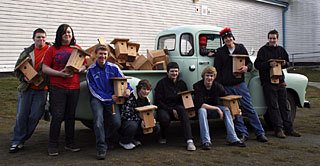For the third year, Mark Padbury’s wood shop class at Orcas High School has built birdhouses for the San Juan Preservation Trust’s Western Bluebird Reintroduction project.
The first year the class built 25 houses, and for the last two years they have constructed 50 homes for local bluebirds.
The bluebird project is made possible through a collaboration of The American Bird Conservancy, the San Juan Preservation Trust, the San Juan County Audubon Society, and the Ecostudies Institute. They are working to reestablish a breeding population of Western Bluebirds (Sialia mexicana) in the San Juans.
The project was initiated in Spring 2007 and will continue over a five-year time period, which is the estimated time needed to establish a stable population.
Western Bluebirds were considered common in the San Juan Islands in the 1930s, but vanished by 1964. The cause for their decline was due less to loss of their habitat type (prairie-oak), than it was to loss of a habitat element: cavities for nesting. The establishment of nestbox programs has been used successfully to restore bluebird populations in many areas of North America.
To reestablish a breeding population of Western Bluebirds in the San Juan Islands, Washington and Vancouver Island, British Columbia, birds are being relocated from an expanding population on the Fort Lewis Military Installation.
The plan is to relocate five to 10 pairs of bluebirds each year with a target of approximately 90 adult bluebirds to be reintroduced.
“We had a large number of babies born on San Juan Island last year, and we’re hoping some of them will return after their fall migration,” said Kathleen Foley, Director of Education and Outreach for the preservation trust.
“We’re thinking the chances of them returning are fairly good. A lot of the pairs that nested last year stuck around the islands until early December. We’re hoping we didn’t lose too many in that cold front. They are early returners, so we expect to see them return around the end of February and early March.”
Foley says they are prepping everyone to get their nestboxes ready for the birds’ arrival.




